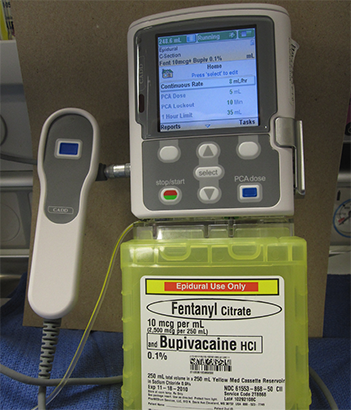4.5 Central Nervous System Agents
A key category in the F&C is the central nervous system (CNS), which consists of specialized nerve cells called neurons located in the brain and spinal cord. Neurons communicate with each other primarily through chemicals known as neurotransmitters. Prescribed drugs often alter the neurotransmitter activity at the neuron level to produce medicinal effects, which also can produce side effects that must be considered.
Analgesic and Anti-Inflammatory Agents
Analgesic medications are used to relieve or reduce pain, whereas anti-inflammatory drugs work to reduce swelling. Multiple common medications in the subcategory of analgesic and anti-inflammatory agents act upon the CNS and nerves (see Table 4.3).
 Put Down Roots
Put Down Roots
Analgesia comes from the Greek algein, “to feel pain,” with the prefix an, meaning “not.” It means to not feel pain or to result in painlessness.
Narcotic Analgesics
Narcotics are pain relieving drugs that may substantially affect mood and behavior. Narcotics are highly addictive with particular contraindications and restrictions of use since they can cause a great deal of harm if misused. Narcotics have the following effects:
analgesia, relieves or reduces pain
sedation, allays anxiety and causes drowsiness
euphoria, produces feelings of extreme high mood and energy
dysphoria, develops feelings of anxiety, disordered thoughts, hyperfear, restlessness, malaise, or hallucinations
 Name Exchange
Name Exchange
APAP is an abbreviation for nonnarcotic acetaminophen. The abbreviation comes from the active ingredient acetyl-paraaminophenol. When combined with a narcotic, APAP often offers better relief for pain than either drug alone and at lower doses.
All narcotics are listed by the DEA as controlled substances because they are potentially addictive, meaning they may cause greater tolerance (need for higher doses for the same effects), physical and psychological dependence, and addiction. (There will be more on this in Chapter 14.)
Common narcotic analgesics are the opiates, which are drugs from the opium poppy plant, including heroin (illegal), morphine, and codeine. Opioids are synthetically made narcotics that offer opium-like effects of reduced perception and reaction to pain, and increased pain tolerance. Opioids often include opium elements but are chemically designed to have varied or extended opium-like effects. Medications that fall into this category include hydrocodone, oxycodone, and other related drugs (note the suffix – codone). adjuvant medications are helper medications. They are not strictly used for pain, but they help in pain management and may be prescribed along with a pain reliever. Some common adjuvants are antidepressant and antiseizure medications, muscle relaxants, sedatives, or sleep-enhancing drugs.
 Safety Alert
Safety Alert
Oxycodone is a potent Schedule II drug that is available as both an immediate-release generic drug and a long-acting brand name drug (OxyContin). It is important for the pharmacy technician to distinguish between the short- and long-acting formulations when entering the drugs into the computer to avoid medication errors.
Hydrocodone is the generic name for a powerful opioid narcotic pain reliever. Hydrocodone combination drugs (Lortab, Norco, and Vicodin) are by far the most popular prescribed pain medications. Hydrocodone drug combinations are Schedule II drugs with no refills permitted.
Oxycodone (OxyContin, Roxicodone) offers strong, narcotic pain relief. Many hydrocodone, oxycodone, and codeine preparations also contain acetaminophen, which increases their analgesic effects.
In the hospital setting, injections of fentanyl, morphine, and hydromorphone (Dilaudid) are commonly used for temporary relief of severe pain. For terminally ill hospice or cancer patients, around-the-clock narcotics—administered via infusion pumps, as liquids, or in controlled-release solid dosage forms or patches—are commonly and appropriately used to provide comfort and pain relief.

Opiates come from the Middle Eastern opium poppy plant (Papaver somniferum). The familiar red corn poppy (Papaver rhoeas) from Flanders Fields is related but does not contain hallucinogens.
Narcotic analgesics can cause stomach upset and constipation. Therefore it is recommended that these medications be taken with food, and if constipation occurs, a stool softener or short-term laxative may be recommended. Narcotic analgesics are generally considered CNS depressants, and they can cause drowsiness. Depressants are drugs meant to reduce activity and nervous action; they include sedatives, tranquilizers, and sleep inducers. It is best to avoid using them with other CNS depressants, such as psychiatric medications, OTC sleeping medications, or alcohol. As described, narcotic analgesics relieve pain, but they also have the potential for misuse (called opioid use disorder). Medication-assisted treatment of opioid use disorder typically includes opioid agonists. Opioid agonists include methadone (Dolophine) and buprenorphine (Subutex). Paradoxically, methadone can also be prescribed for pain management. When methadone is prescribed for the treatment of opioid abuse, it is administered in a controlled setting with direct observation of ingestion. This means methadone for the treatment of opioid use disorder is not dispensed in a typical community pharmacy. However, methadone used as an analgesic may be dispensed in a community or hospital pharmacy. Buprenorphine is usually administered in combination with naloxone (Suboxone, Bunavail, Zubsolv, Cassipa). Buprenorphone/naloxone side effects include sedation, headache, nausea, constipation, and insomnia.
Non-Narcotic Analgesics
Acetaminophen (Tylenol) is a non-narcotic analgesic found in many prescription and OTC products. It is used for children and adults as a fever reducer and pain reliever (for headache and arthritis) that will not upset the stomach. It is considered generally safe to use during pregnancy. However, large total daily doses of acetaminophen (such as more than three grams per day or 5–6 extra-strength tablets per 24 hours) for the average person can damage the liver, especially if combined with alcohol.
 Pharm Fact
Pharm Fact
Though nasal corticosteroids, such as fluticasone propionate (Flonase), are found to be effective for some upper bronchial tract infections, they are not found to reduce symptoms of the common cold. They can even extend sore throat symptoms.
Additional nonnarcotic pain relief medications include lidocaine (Lidoderm) and tramadol (Ultram). Lidocaine is a localized pain reliever that numbs sensation in a specific area. It is available as a patch that is worn for 12 hours and then removed for 12 hours. Tramadol is a narcotic-like substance that is frequently prescribed as around-the-clock pain medication. It was reclassified as a Schedule IV drug in 2014 by the DEA. It should not be taken with alcohol, narcotics, or sedatives, or if these have been used in the last few hours. These nonnarcotic pain relief medications may reduce the dose or frequency of the more potent and addicting narcotic medications.
 Practice Tip
Practice Tip
Careful spelling counts! Many drugs are made of similar base compounds and often share some similar lettering patterns. Not being exact in computer keyboarding or failing to check prescriptions can lead to dangerous medication errors.

A hand-controlled analgesia pump allows patients to regulate the amount of pain medication they receive. This results in better pain control.
Anti-Inflammatory Medications
These drugs fight swelling. A number of anti-inflammatory drugs are steroids, or complex synthetic substances that can resemble human hormones. Corticosteroids, such as cortisone and prednisone, resemble the hormone cortisol, and can be targeted to reduce the body’s natural mechanisms of swelling and white blood cell production. Short-term uses of steroids can be effective, but they can be detrimental if used long-term. That is why they are dangerous. These anti-inflammatory agents are described more fully in the discussion of endocrine agents later in this chapter.
The common anti-inflammatory drugs listed in Table 4.3 are often called nonsteroidal anti-inflammatory drugs (NSAIDs) and include ibuprofen and naproxen. NSAIDs come in a variety of common prescription and OTC forms. NSAIDs are not only used to deal with short-term pain and headaches but also chronic conditions, such as rheumatoid arthritis, migraines, and backaches. In conditions where swelling and pain are linked, many of the medications, such as ibuprofen (Motrin), handle both. If a patient is allergic to aspirin, an NSAID cannot be used.
Table 4.3 Common Analgesic and Anti-Inflammatory CNS Agents
Generic Name |
Trade Name |
Classification |
|---|---|---|
Pain Relief |
||
acetaminophen |
Tylenol, Panadol, Anacin |
Nonnarcotic analgesic |
buprenorphine/naloxone |
Suboxone, Subutex (no naloxone) |
Narcotic analgesic/antagonist |
codeine |
various trade names |
Narcotic analgesic |
fentanyl |
Duragesic, Actiq |
Narcotic analgesic |
hydrocodone/APAP |
Lortab, Norco, Vicodin |
Narcotic analgesic |
hydromorphone |
Dilaudid |
Narcotic analgesic |
lidocaine |
Lidoderm |
Anesthetic analgesic |
morphine |
Kadian, MS Contin |
Narcotic analgesic |
oxycodone |
OxyContin, Roxicodone |
Narcotic analgesic |
oxycodone/APAP |
Percocet, Endocet |
Narcotic analgesic |
tramadol/APAP |
Ultracet, Ultram (no APAP) |
Central analgesic |
Anti-Inflammatory |
||
celecoxib |
Celebrex |
COX-2 inhibitor |
ibuprofen |
Advil, Motrin |
NSAID |
meloxicam |
Mobic |
NSAID |
naproxen |
Aleve, Naprosyn |
NSAID |
NSAID = nonsteroidal anti-inflammatory drug
Anti-inflammatory agents are nonnarcotics but can cause serious gastrointestinal (GI) bleeding if taken in large doses for an extended period of time, especially in older individuals. It is recommended that NSAIDs always be taken with food, milk, or a snack. These drugs may negate the beneficial blood-thinning effects of aspirin when taken at the same time. Celecoxib (Celebrex) is less likely to cause GI side effects and bleeding, but it is much more costly. If a patient is allergic to sulfa drugs (drugs containing sulfur derivatives), celecoxib is contraindicated, or not recommended.
Adjuvant Medications
Adjuvant medications are helper medications. They are not strictly used for pain, but they help in pain management and may be prescribed along with a pain reliever. Some common adjuvants are antidepressant and antiseizure medications, muscle relaxants, sedatives, or sleep-enhancing drugs. The individual adjuvant medications will be discussed with their appropriate body system in this chapter.
Antianxiety and Hypnotic CNS Agents
Antianxiety and nhypnotic drugs are psychoactive drugs, medications targeted to modify the brain functions to influence mood, perception, and consciousness. Hypnotic drugs are those that induce sleep. The commonly dispensed antianxiety and sleep medications listed in Table 4.4 are also CNS depressants; they have the same limitations as the narcotic analgesics, such as not mixing them with psychiatric medications, OTC sleeping medications, or alcohol.
The psychoactive drugs in the benzodiazepine (BZD) family (the “benzos”) are used to treat anxiety, panic attacks, seizures, and insomnia. They include diazepam (Valium), and lorazepam (Ativan). Benzodiazepines generate some degree of physical or psychological dependence if used long-term.
The non-benzodiazepine sedatives zolpidem (Ambien) and eszopiclone (Lunesta) may also bring about physical or psychological dependence. Due to their dependence profile, benzos and the aforementioned non-benzodiazepines sedatives have been classified at the Schedule IV level. Refills of Schedule IV drugs must occur within six months of the original prescription date, and are limited to five refills. Prescriptions must also be monitored for early refills and abuse. Most medications with strong dependence profiles are recommended for short-term or “as-needed” use. In practice, though, many are used on a long-term, routine basis for anxiety or insomnia. The non-benzodiazepine sedatives have warnings for abnormal thoughts, CNS depression, and an increase in hazardous sleep-related activities (such as sleep-driving).
Table 4.4 Common Antianxiety and Hypnotic Agents
Generic Name |
Trade Name |
Classification |
|---|---|---|
Antianxiety |
||
alprazolam |
Xanax |
Benzodiazepine |
clonazepam |
Klonopin |
Benzodiazepine |
diazepam |
Valium |
Benzodiazepine |
lorazepam |
Ativan |
Benzodiazepine |
Anti-insomnia |
||
eszopiclone |
Lunesta |
Non-benzodiazepine |
temazepam |
Restoril |
Benzodiazepine |
zolpidem |
Ambien |
Non-benzodiazepine |
Antipsychotic and Antidepressant Agents
Antipsychotic and antidepressants drugs (see Table 4.5) often act on neurotransmitters, such as serotonin, norepinephrine, and dopamine, to achieve a therapeutic effect. Serotonin is a hormonal neurotransmitter that affects memory, mood, appetite, sexual desire and function. It is thought that too little serotonin can lead to depression—a common but serious disorder that can affect mood, thinking, or ability to engage in daily activities, such as working, eating, or sleeping. Too much serotonin can lead to agitation, high heart rates, and confusion.
 Name Exchange
Name Exchange
The British term adrenaline, or the “stress” hormone (triggering the fight-or-flight response), is known in American and international healthcare communities as epinephrine. So adrenaline is epinephrine, and noradrenaline is norepinephrine.
Norepinephrine is considered the “stress hormone” that helps us address challenges with increased breathing, blood pressure, and sugar levels, but too much can lead to overstressing the system and psyche.

Treatment for depression may involve a combination of medication and psychotherapy.
Dopamine is associated with movement, sexual desire, motivation, pleasure, and enjoyment. Modulating one or more of these elements to assist patients in living their everyday lives well is the purpose of antidepressant and antipsychotic drugs.
It is possible for antipsychotic and antidepressant drugs to work for a period of time and then lose their effectiveness as the body develops a tolerance. Also, some drugs can bioaccumulate, or collect in the fat cells of the body, resulting in the development of side effects after taking a drug for some time. Patient education and adherence are important while taking antipyschotics and antidepressants; a patient may experience withdrawal symptoms—or adverse reactions such as anxiety, sweating, nausea, shaking—if the drug is stopped abruptly. These drugs should always be tapered off.
Antipsychotics
Antipsychotic drugs are used to manage disordered thought and personality behaviors, such as delusions, hallucinations, mania, and severe agitation, which manifest themselves in diseases like schizophrenia and bipolar disorder. These drugs can also be used to treat severe anxiety and depression. Major depressive disorder or depression (intense, prolonged sadness) is dangerous, sometimes leading to suicide, and can accompany other mental health conditions.
The first antipsychotic drugs developed, including chlorpromazine (Thorazine) and thioridazine (Mellaril), were used to treat schizophrenia. The drugs are rarely prescribed today because of the higher incidence of side effects, such as blurred vision, dry mouth and related dental problems, and dementia-like symptoms. Other drugs and formulations have encountered success with fewer difficult side effects due to the blockage of certain brain functions.

Anxiety, depression, and other mental health conditions can separate people from their friends and loved ones. Medications can sometimes relieve the symptoms so that patients may reconnect and lead more satisfying, normal lives.
Aripiprazole (Abilify), olanzapine (Zyprexa), quetiapine (Seroquel), and risperidone (Risperdal) are considered atypical antipsychotic drugs because they target specific neurotransmitters. By balancing the levels of these hormone transmitters, the brain seems to function more effectively, and depression often remits. The atypical antipsychotic drugs are often used to enhance the antidepressant effect of traditional antidepressants. In addition to modulating bipolar disorder (excessively low mood, energy, and activity) and mania (excessively high mood, energy, and activity), these drugs are used in adults to treat schizophrenia (mental and emotional fragmentation and faulty reality perception) and severe agitation. However, these drugs may cause or aggravate diabetes and high cholesterol. They should be used cautiously in older adults due to potential cardiovascular adverse reactions. If the patient experiences any rigidity, tremor, or involuntary muscle twitching, the physician should be notified immediately. Alcohol should not be used while taking these drugs.
 Safety Alert
Safety Alert
The antidepressant Celexa is often confused with the arthritis treatment Celebrex (brand name for the generic drug celecoxib). That is why it is so important to watch for correct spelling.
Antidepressants
Twelve of the most common CNS agents being used in the United States today are used primarily for the treatment of depression. As shown in Table 4.5, these drugs have various classifications and mechanisms of action. Although all the common medications listed are used to treat depression, the specific type and dose must be individually tailored to each patient to achieve the correct therapeutic response. Antidepressants carry boxed warnings because of the increased risk of suicidal thoughts and behavior in children, adolescents, and young adults. The generic amitriptyline (Elavil) is an older antidepressant drug that offers a mild tranquilizing, soothing result. It is still used for depression, to enhance the effect of pain medications, and to prevent migraine headaches. This drug commonly causes drowsiness and is sometimes prescribed to treat insomnia. Amitriptyline can cause a dry “cotton” mouth and blurry vision.
Table 4.5 Common Antipsychotic and Antidepressant CNS Agents
Generic Name |
Trade Name |
Classification |
|---|---|---|
Antidepressants |
||
aripiprazole |
Abilify |
Atypical antipsychotic |
citalopram |
Celexa |
SSRI |
escitalopram |
Lexapro |
SSRI |
fluoxetine |
Prozac |
SSRI |
olanzapine |
Zyprexa |
Atypical antipsychotic |
paroxetine |
Paxil, Paxil CR |
SSRI |
quetiapine |
Seroquel |
Atypical antipsychotic |
risperidone |
Risperdal |
Atypical antipsychotic |
sertraline |
Zoloft |
SSRI |
trazodone |
Desyrel |
Serotonin reuptake inhibitor/antagonist |
venlafaxine |
Effexor, Effexor ER |
SNRI |
Antidepression, Pain Relief |
||
amitriptyline |
Elavil |
Tricyclic antidepressant |
duloxetine |
Cymbalta |
SNRI, DA reuptake inhibitor |
SSRI = selective serotonin reuptake inhibitor; SNRI = serotonin-norepinephrine reuptake inhibitors; DA = dopamine
Trazodone has a different mechanism of action from some of the other drugs but is also used as an antidepressant. It can also cause drowsiness and is sometimes prescribed for enhancing sleep. It has similar side effects of dry mouth, vision changes, and some hangover-like effects the next morning. Patients taking trazodone should avoid sun exposure, and males should be warned about the risk of priapism, or aprolonged painful erection. In some patients, trazodone can cause cramps in ankles and feet and some loss of small motor function after prolonged use.
Selective serotonin reuptake inhibitors (SSRIs) are antidepressants that block the reabsorption of serotonin so that more of the secreted serotonin circulates for positive effects. Several antidepressants, including the famous Prozac, generically known as fluoxetine, work in this way. Drugs like fluoxetine, venlafaxine (Effexor), and duloxetine (Cymbalta) may cause insomnia if given at bedtime. Venlafaxine and duloxetine should be used cautiously in patients with hypertension as they can elevate blood pressure.
Several prescription (and some OTC) drugs, such as tramadol (Ultram) and cyclobenzaprine (Flexeril), can cause unsafe levels of serotonin when used with certain antidepressants such as fluoxetine (Prozac), sertraline (Zoloft), and paroxetine (Paxil), causing confusion and agitation. Alcohol should not be used with these drugs either.
 Work Wise
Work Wise
Since many patients on ADHD medications are children, their parents naturally are worried and have numerous questions and concerns. You cannot counsel them, but you can refer them to the pharmacist and answer billing and insurance questions.
Miscellaneous CNS Agents
The diagnosis of attention deficit hyperactivity disorder (ADHD) is on the rise in pediatric patients. It manifests itself in difficulty focusing or concentration, overactivity, and difficulty in impulse control. Ironically, the usually prescribed drugs, such as methylphenidate and amphetamines, stimulate rather than depress the CNS, and this actually helps support the brain in focusing attention and behavior. Common side effects are insomnia and loss of appetite. Medications for ADHD should be taken in the morning or early afternoon.
Methylphenidate is available as both an immediate-acting drug (Ritalin) and as a longer-acting drug (Concerta). Amphetamines, or “uppers” as they have been called, are very dangerous because of their addictive qualities. The popular Adderall and Adderall XR (short- and long-acting formulations) are combinations of amphetamine salts. Lisdexamfetamine (Vyvanse) is also prescribed for ADHD. Due to the amphetamine content of these drugs, the DEA places them in the Schedule II category—no refills are authorized without a new prescription.
 Safety Alert
Safety Alert
ADHD medications can be abused. Many of these medications are Schedule II drugs and need to be dispensed carefully. As a pharmacy technician, it is important for you to exercise caution and to dispense ADHD medications in accordance with laws and regulations for the safety of yourself and your patients.
Unfortunately, drugs to treat ADHD may be abused. Patients might share their ADHD medications with friends who want to “focus” on a test or desire extra energy. Abuse of ADHD drugs is an evolving problem.
To slow the progression of moderate to severe Alzheimer’s disease, other CNS agents, such as memantine (Namenda) and donepezil (Aricept), are used. These potent medications alter brain chemistry in an effort to generate the desired therapeutic response. Memantine is sometimes used in combination with donepezil, but drowsiness is a common side effect. Donepezil is metabolized in the liver so it is susceptible to drug interactions. The main side effects of donepezil are gastrointestinal, such as diarrhea, nausea, and vomiting. Additional drugs that help regulate or stimulate the CNS are listed in Table 4.6.
Table 4.6 Miscellaneous Central Nervous System Agents
Generic Name |
Trade Name |
Classification |
Indication |
|---|---|---|---|
amphetamine salts |
Adderall |
CNS stimulant |
ADHD |
carisoprodol |
Soma |
Skeletal muscle relaxant |
Muscle spasms |
cyclobenzaprine |
Flexeril |
Skeletal muscle relaxant |
Muscle spasms |
gabapentin |
Neurontin |
Anticonvulsant, analgesic |
Pain, seizures |
lisdexamfetamine |
Vyvanse |
CNS stimulant |
ADHD |
memantine |
Namenda |
Brain receptor antagonist |
Alzheimer’s disease |
methylphenidate |
Concerta, Ritalin |
CNS stimulant |
ADHD |
metoclopramide |
Reglan |
Prokinetic agent |
GERD, gastroparesis |
ondansetron |
Zofran |
Serotonin receptor antagonist |
Nausea, vomiting |
pregabalin |
Lyrica |
Anticonvulsant, analgesic |
Pain, seizures |
promethazine |
Phenergan |
Antidopaminergic, antihistamine |
Nausea |
ropinirole |
Requip |
Dopamine agonist |
Restless legs, Parkinson’s |
sumatriptan |
Imitrex |
Serotonin agonist |
Migraine headache |
tizanidine |
Zanaflex |
Alpha2-adrenergic agonist |
Muscle spasms |
topiramate |
Topamax |
Unknown |
Migraine headache, weight loss, epilepsy |
ADHD = attention-deficit/hyperactivity disorder; CNS = central nervous system; GERD = gastroesophageal reflux disease
Epilepsy is a disease where a patient suffers from seizures, which are spasms caused by overfiring of the neurons of the brain and nervous system. Seizures come in varying levels of severity. Patients are given anticonvulsant (antiseizure) medications to calm the nervous system by inhibiting the overly rapid and excessive firing of neurons. The most common drugs used to treat active seizures are benzodiazepines, such as lorazepam (Ativan) and clonazepam (Klonopin), which are also antianxiety drugs.
Gabapentin (Neurontin) and pregabalin (Lyrica) were initially used to control seizures. Today, though, these drugs are primarily used to reduce nerve pain associated with diabetes, chronic pain, shingles, and spinal cord injuries. Pregabalin is sometimes prescribed for fibromyalgia, or severe chronic muscle fatigue. The most common side effects of these drugs are drowsiness, dizziness, and swelling of the ankles. OTC antacids, such as Mylanta or Maalox, interfere with the absorption of gabapentin. It is recommended that pregabalin be administered at least one hour before or two hours after the patient takes antacids.
Muscle relaxants, which reduce muscle strain and pain, include carisoprodol (Soma) and cyclobenzaprine (Flexeril). These are commonly prescribed with narcotic analgesics and antianxiety drugs. They are indicated for short-term treatment of muscle spasms; however, they are often used long-term.
Promethazine (Phenergan) is commonly used in tablet, liquid, injection, or suppository forms for the treatment of nausea and vomiting from a viral illness or migraine headache.
Sumatriptan (Imitrex) is available in various dosage formulations to treat an occasional severe migraine headache. It must be used with caution in patients with heart disease and women of childbearing potential.
Metoclopramide (Reglan) is used to treat heartburn and slow stomach emptying in patients with diabetes as well as severe nausea and vomiting resulting from chemotherapy. It is commonly given 30 minutes prior to each meal and at bedtime; it can cause some severe abnormal muscle movement with long-term use. Ondansetron (Zofran), also used for stomach distress from chemotherapy, is available as an oral disintegrating tablet (ODT), as a syrup, and as an injection for pediatric patients or those too sick to swallow tablets. Ropinirole (Requip) is commonly prescribed at bedtime to treat “restless legs syndrome” (involuntary twitching of the legs). Common side effects with all these drugs are drowsiness and dizziness; as with most CNS drugs, alcohol must be avoided.